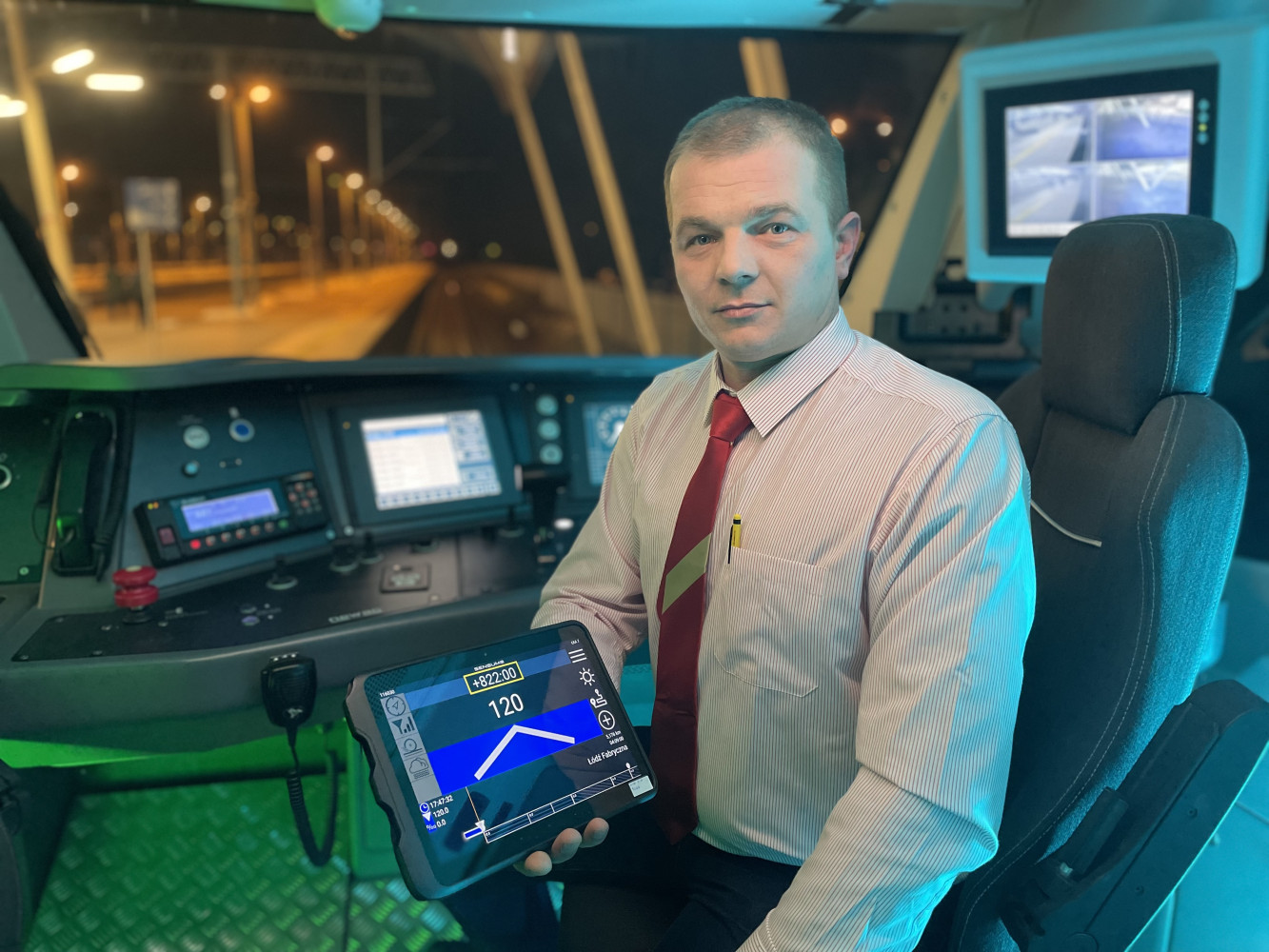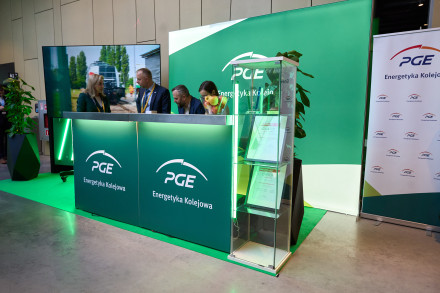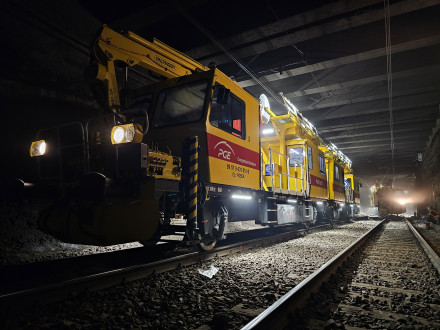Eco-driving on Polish tracks. Success of the first phase of testing our app, which helps save traction energy.
20.12.2022, 10 min. read
For more than a month, 5 drivers from Koleje Mazowieckie (Mazowieckie Voivodeship Railway) and 14 drivers from Łódzka Kolej Aglomeracyjna (Łódź Agglomeration Railway) have been testing how SENSUM – the eco-driving system for railwaymen, developed under one of the main initiatives of the PKP Energetyka Center for Railway Energy Efficiency – works in practice. Nearly 150 carriages were implemented, which confirmed the high precision of the system and the correctness of the teletechnical data. KM and ŁKA, as leaders participating in the development and implementation of the system, are co-creating this innovative solution improving the efficiency, safety, and punctuality of carriages.


What is eco-driving? This is conscious, skillful and economical driving, allowing to use the lowest possible amount of energy or fuel. In railway transport, eco-driving must take into account many additional factors. First of all, the time table, weather conditions, attendance and type of vehicle. Therefore, the driver has much information to analyze and many decisions to make in a short period of time. The SENSUM algorithm, which is being tested, collects and analyzes these data, and the driver receives precise instructions, similar to those we receive from the GPS navigation system. That is why it is called the “sixth sense of the driver.”
SENSUM consists of two elements communicating with each other. The central system (the “brain” of the solution) – i.e. the algorithm which collects and interprets the data and the on-board terminals – tablets with the app which are placed in the cabs. During the tests, it was checked whether the tablets, on an ongoing basis and in real time, displayed precise instructions and prompts corresponding to real-world conditions. The algorithm processed more than 500,000 records to the system, each with a 10-second range of data. The obtained effects confirmed the high accuracy of the network model in the range of carriages being implemented and positively verified the assumptions as to the method of handling telemetry signals received from the vehicles.
In parallel, the tablets collected and sent data from the vehicles (such as speed, driving dynamics, energy consumption, etc.) feeding the central system. In this system, just like in the brain, not only aggregations and interpretations of data take place, but also calculations and multivariate simulations. It was confirmed that SENSUM’s “brain” has a very high learning capacity based on recorded carriages, which allows to continuously optimize the solution. The tests also confirmed that SENSUM works continuously, also offline, when there is no network coverage.
The results were obtained during four weeks of monitoring nearly 150 time table carriages with a total duration of about 140 hours. The carriages were implemented by 17 selected drivers using 8 terminals of the system. The carriages were recorded on the following types of vehicles: 36Wed, 45WEkm, EN57AKMwl, EN57AL.wKM, EN76, ER160, LM4268.
“An important part of this testing phase was to collect feedback from the drivers, including recommendations regarding the scope and method of presentation of information in the cab, in order to increase their work comfort and situational awareness. I am particularly pleased that the drivers confirmed the high precision of, among others, indicating the train’s stopping points, which greatly facilitates their work in the conditions of low visibility. We put a very strong emphasis on the fact that SENSUM provides comprehensive instructions to support decision-making with regard to driving safety” – said Witold Bartnik, CEO of REDS, the company responsible for the system’s technological solutions.
“The SENSUM app is a tool that not only streamlines the driver’s work, but enables greener driving as well, also in difficult conditions. Technology analyzing the conditions of carriage ensures smoother driving and reduces the use of rapid acceleration or braking, which generate the consumption of more traction energy. What is important, the aforementioned analysis also works according to the principle of remembering routes, which also affects further carriages on the same section of the line” – assessed Czesław Sulima, Member of the Management Board, Operations Director of Koleje Mazowieckie.
“We act innovatively and with care for the environment. We use green energy to power our trains and maintain technical facilities. We introduced recuperation and eco-driving, thanks to which we reduced the consumption of electricity by about 25%. We want to use energy as efficiently as possible by reducing our carbon footprint, and SENSUM will allow us to do so even more” – stressed Janusz Malinowski, President of the Management Board of Łódzka Kolej Aglomeracyjna, Chairperson of the Presiding Committee of the CEEK Program Council.
What essential benefits of SENSUM were confirmed in tests?
Smooth driving = less energy consumed.
SENSUM complements the missing elements in situational awareness of the drivers, making them “see” much more. It works similarly to the car navigation system, which, for example, indicates speed limits or obstructions along a route. This allows the driver to react in advance, by adjusting the style and speed and driving the train more evenly – without rapid braking or accelerating. This translates directly into the optimized driving technique, while reducing the amount of traction energy or fuel consumed.
“I have six years of experience as a train driver and I know that the majority of energy – both my own and the vehicle’s – is lost during the so-called extended driving. This type of driving results in less comfortable travel, as it is based on rapid acceleration and braking of the train set, which is not always necessary. Now the tablet says beforehand that I do not need to drive at full speed to get to the next stop on time, and I travel along this section using less energy” – said Filip Pełkowski, KM driver.
Support in timely driving
In the railway industry, timely driving is when the train covers the given sections within a precise, pre-defined period of time – it arrives to the destination station neither earlier nor later. During the tests, the drivers appreciated the fact that SENSUM helps them drive on schedule, by giving them instructions based on analyzing, among others, the specifics of railway traffic in a given area, time of reaching the station or unexpected restrictions. The value of the system is a specific hint, such as “slow down to 20 km/h”, rather than just routine information about the state of the route or the speed limit. At the same time, it was pointed out that when reaching the station the information should be provided about the distance (in meters), not about the time of reaching the station (in minutes). Such hints are very valuable and will be taken into account during the refinement of SENSUM and tested in the next phase.
Interface, or the friendly “face” of SENSUM
SENSUM is not only technologically advanced, but also user-friendly. The interface – the appearance of the tablet’s screen – was developed based on the suggestions of the drivers themselves, so that the amount and arrangement of the information presented was graphically friendly and best adapted to their needs.
It is planned to ensure compatibility with other devices with which the driver works. During the tests, it was suggested, among others, to integrate the app with the time table displayed on the carrier’s tablet.
Railway “GPS” system operating in real time
Just like “reporting obstructions” in GPS, SENSUM enables communication between the drivers within the system. This functionality was also confirmed during the tests. The drivers reported obstructions, such as icing, reduced visibility and the so-called slippery rail. Ultimately, SENSUM will analyze and send information about the possibility of a phenomenon to all vehicles within reach. Access to such messages in real time will clearly result in the safety of entire railway traffic. As part of further testing phases and during the development of the product, this and other functions will be added to the system which still has many technological and IT capabilities. Just like with any solution of this type, it is essential that it is used by as many vehicles as possible throughout the country. The economies of scale will make the system’s indications more accurate and complete.
Co-creation, i.e. the process of SENSUM development
The SENSUM tests are being implemented as part of an industry initiative by the Center for Railway Energy Efficiency (CEEK). This is the next step in the process of developing this innovation, which started in February 2020. Back then, the first workshop dedicated to economical driving was held, which was attended by train drivers and drivers-instructors from railway companies across Poland, both freight and passenger ones. The conclusions made during the workshop were helpful in creating the system, and the comments made were taken into account in further work on SENSUM. The current test phase is a natural consequence of the previous two phases of developing the system in a co-creation model, i.e., the joint creation of a valuable solution which is best adapted to the needs of the end user.
In this way: in stages, in close cooperation with the carriers, who in each iteration check the validity and usefulness of the adopted solutions, the project is being implemented by PKP Energetyka in cooperation with Polish IT specialists and engineers from the REDS company. This is a unique approach in the railway market and proof of successful B2B cooperation.
“Our mission is to support the development of the Polish railways. In proposing innovative solutions for the industry, we invite our clients into the process of their creation, at every stage – from the moment of conceptual planning to practical tests of the jointly developed tool. From the beginning, SENSUM has been subjected to the verification of the end user – i.e. the drivers. It is to be primarily useful in everyday work, only then will it be used and perform its functions” – informs Leszek Hołda, Member of the Management Board of PKP Energetyka, which developed and implements SENSUM.
Eco-driving on European tracks
The issue of eco-driving in the railway industry has been explored for many years in other European countries. For example, Nederlandse Spoorwegen (Dutch Railways) launched a pilot project in this area as early as 2010. The program is continued with the support of special apps for drivers implemented by both the carrier and the infrastructure operator. An analogous initiative is being implemented by SNCF (the main carrier in France), which announced that all of its trains would be included in the eco-driving program this year. Advanced driver support systems are also in use at CFL (Luxembourg), Deutsche Bahn (Germany), LKAB (Sweden), SOB (Switzerland) and in the UK.
CEEK assumes that the implementation of a coherent system for eco-driving for the railway industry will allow to generate energy savings of 400 GWh and reduce CO2 emissions by 320,000 tonnes. The next stage in phase IV will be the production start-up of the system, which is scheduled for next June.






